“I think it’s great. I think it’s iconic… I’m excited to vote aye.”
— Ted Wheeler, Portland Mayor
Just over five years after it first hit the street as a low-budget pilot project, Better Naito received official blessing from Portland City Council this morning.
The project, estimated to cost $5 to $7 million, will permanently re-configure northbound lanes of Northwest Naito Parkway from the Hawthorne Bridge to Northwest Davis and add a new sidewalk in Waterfront Park.
It all started as an ambitious vision from nonprofit Better Block PDX and a team of Portland State University urban planning and engineering students. One of them, Gwen Shaw, now a civil engineering consultant at local firm, testified to council this morning. “It’s been so gratifying to see the evolution of this project,” Shaw said, “This design, puts people first and it’s a design that makes Waterfront Park better, and it’s going to continue to transform Naito Parkway.”
The Portland Bureau of Transportation worked closely with activists to implement the project from the beginning and took over management of it in Spring 2017. When a list of projects was created for implementation through the Central City in Motion plan later that year, Better Naito emerged as a top priority. The current PBOT-run iteration of Better Naito has been up since January 2019.
Better Naito Forever will come with significant upgrades. PBOT is planning a two-way bike lane protected by concrete curbs and steel bollards, median islands to make crossings safer, new traffic signals, and a new sidewalk along the western edge of Waterfront Park to separate people on foot from bicycle users.
Mayor Ted Wheeler and Commissioners had nothing but praise for the project today.
“I think it’s great. I think it’s iconic. I think it’s one of those things that makes Portland really unique and special,” Wheeler said as he described it as a “win-win-win” for Vision Zero, climate action, and public health.
Advertisement
Commissioner Jo Ann Hardesty credited the enthusiasm of Better Block PDX volunteer and leader Ryan Hashagen for helping her see the value of the project. She thanked Hashagen profusely following his testimony today and gave credit to him and other volunteers for gathering the data, “to make sure this [project] made sense” to downtown interests. Hardesty also said, “Sometimes it takes government a little while to move, and sometimes a community of volunteers can move much faster,” which is sort of the entire point of Better Block’s approach.
With today’s vote, council gives permission to PBOT to seek bidders and ultimately award a construction contract for the project.
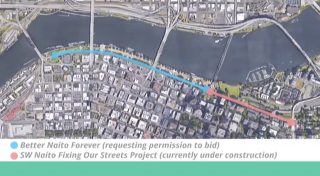
Adding to the buzz about Better Naito Forever is PBOT’s SW Naito Parkway project which broke ground back in July. That $9 million investment will establish a similar protected bikeway between I-405 and Jefferson Street and will tie directly into Better Naito Forever under the Hawthorne Bridge.
At council this morning PBOT Project Manager Gabe Graff explained that both projects were designed by the same team and will “connect seamlessly.” Graff added that PBOT expects to finish construction on the southern section by July 2021 and the northern section will be completed by winter 2021.
With more — and more humane — access to Waterfront Park for people not using cars and trucks, these two projects will transform 1.2 miles of this marquee destination and vital transportation corridor.
Speaking before her yes vote this morning, PBOT Commissioner Chloe Eudaly said, “I think [Waterfront Park] has a lot of unrealized potential and I feel like this project is just another step toward that potential.”
For a refresher on what’s in store for Better Naito, check this PBOT simulation video:
— Jonathan Maus: (503) 706-8804, @jonathan_maus on Twitter and jonathan@bikeportland.org
— Get our headlines delivered to your inbox.
— Support this independent community media outlet with a one-time contribution or monthly subscription.





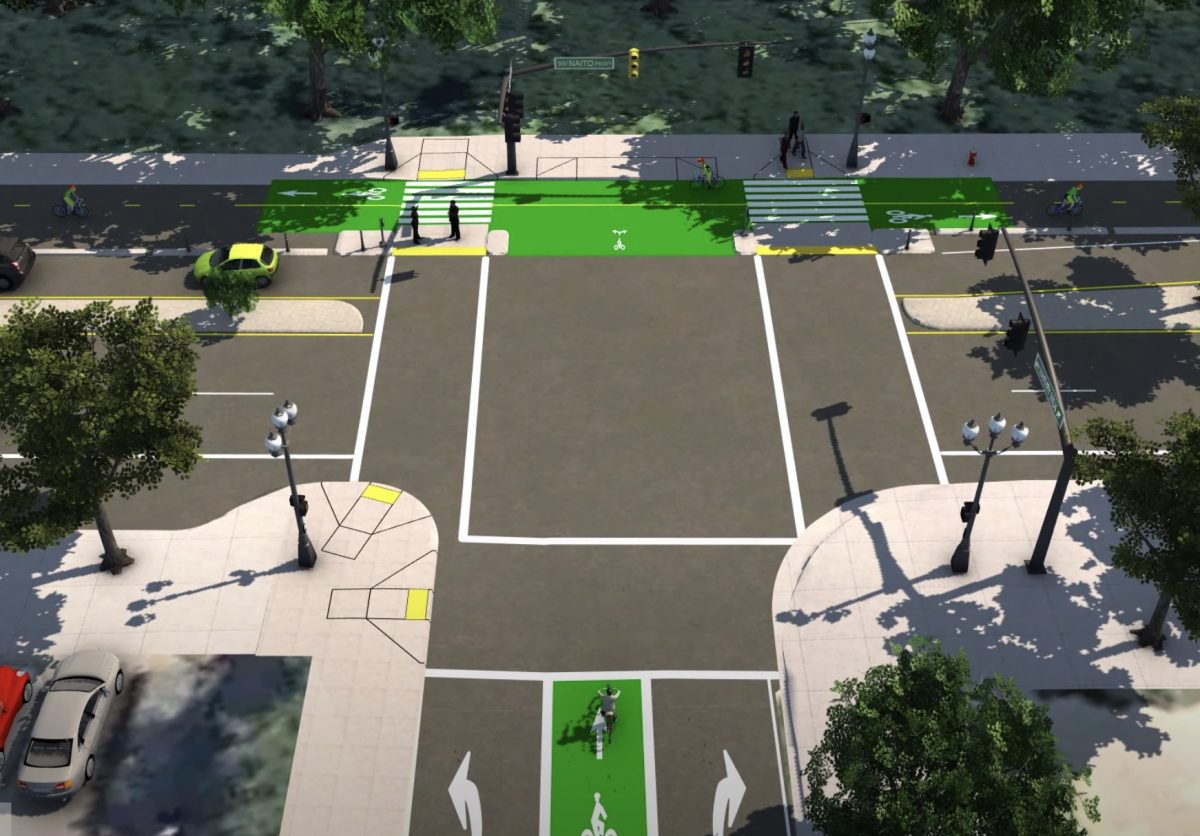
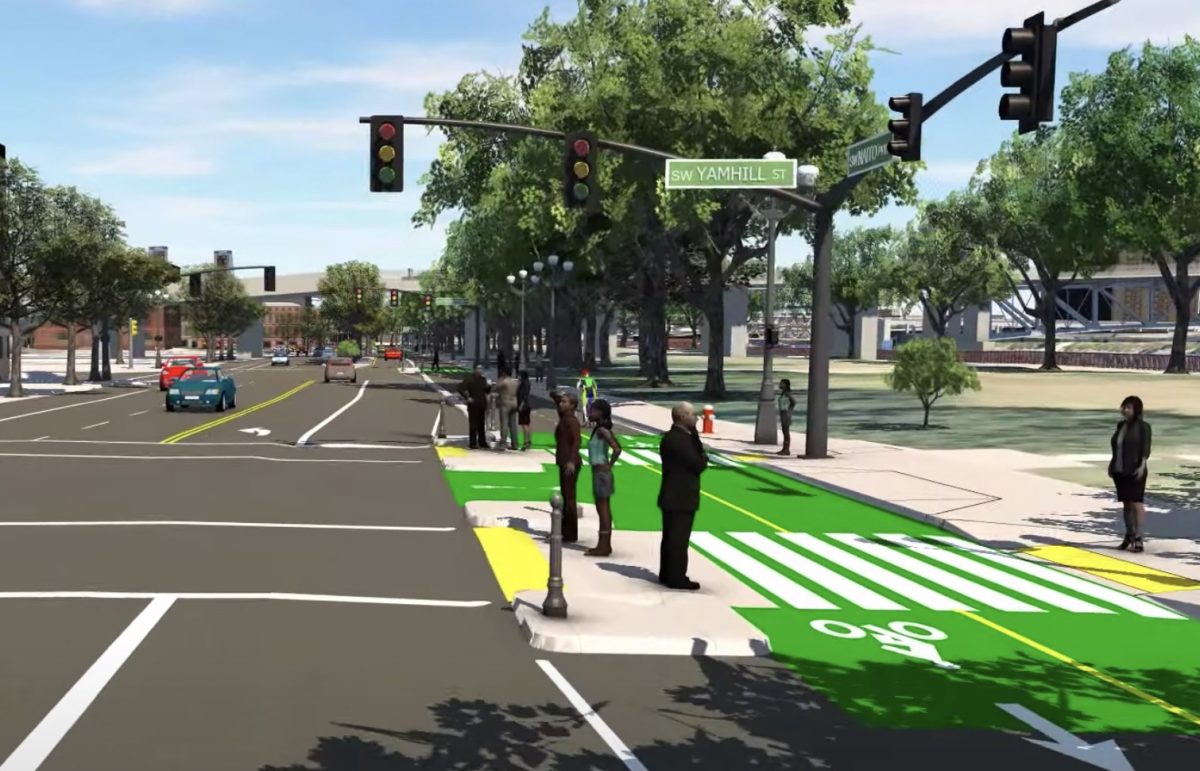

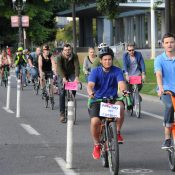

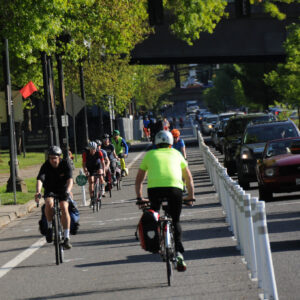
Thanks for reading.
BikePortland has served this community with independent community journalism since 2005. We rely on subscriptions from readers like you to survive. Your financial support is vital in keeping this valuable resource alive and well.
Please subscribe today to strengthen and expand our work.
Fantastic news!
whew lad i hope this thing does not have a ton of those yellow handicap rumble strips
those are the sheer devil when wet, had WAY too many close calls riding over those!!
Today, Nato… tomorrow Powell? 😀
Informal “straw” poll; stopping at traffic lights on Better Nato, yay or nay?
If the bike lane wasn’t physically separated from the road, I’d say yay. But since it’s separated, I say nay. Yielding to pedestrians is feasible without stopping. At least for well adjusted human beings with enough empathy to recognize a pedestrian’s turn to cross.
I’ve had numerous times on Better Naito where I technically had a red but there were no pedestrians crossing and it seemed pointless to stop. Initially, I was more of a “law-abiding citizen”, but I don’t really stop anymore if there aren’t pedestrians who are crossing. Maybe it should be a blinking red for bikes when the pedestrian cycle is green? Mandating all bikes to stop at a red light when there’s no safety-based reason to do so seems like overengineering.
I agree, and upvoted your comment, but would like to ask if it is “overengineering” to ask bikes to stop when there’s no “safety based reason”, is it also overengineering to ask cars to stop in a similar situation?
I think there is some benefit to clear rules that are easy to understand, follow, and adjudicate is something goes wrong.
I guess I’m trying to flesh out the differences as well so bear with me here, but my gut tells me that the two scenarios are different. For one thing, cars are faster and heavier than bikes, and it’s also much easier to miss pedestrians in a car than in a bike due to blind spots and sheer speed. Plus, the risks associated with a car driver making a mistake are much more dire than those associated with a bike rider making a mistake because of the weight difference. So I guess I would go with no, it wouldn’t be overengineering when the rule is applied to cars. Anyone else have any thoughts?
A pedestrian crossing MV lanes with a Walk signal has a reasonable right to assume that their tunnel of relative safety extends to the footpath on the opposite side. Bike riders won’t be 100% alert and respectful, being human. Design problem.
Only stop if a pedestrian is present.
My understanding is that in Better Naito Forever there will be bicycle specific lights at heavily used pedestrian crossings (i.e. Salmon Springs, Saturday Market) where cyclists will be expected to stop on red. Otherwise cyclists won’t be expected to stop when cars have a red, but still should yield when pedestrians are crossing the bike lanes.
My experience with T-intersections is that people will only stop (or slow) when necessary, (someone walking is crossing), and not other times. This is normal human behaviour and should be expected and designed for.
The cycle path should have enough separation from the main road that it would be considered a path and not a lane meaning that traffic signals meant for the main road don’t apply to it. It should have its own rules. It could simply have yield signs at the intersections. That way people will slow down to let someone cross, stop if the timing makes that necessary but at other times they will not be made into a law breaker when nobody is crossing.
Overall great, and so was the video, with its pausing and panning around each intersection.
One thing–the yellow tactile warnings seem wrong. You step off the sidewalk on the water side, over the yellow strip that tells you you’re in bike traffic. Then you cross the bike lanes and step onto the one on the other side, telling you you’re leaving the traffic area. Then you step forward and get run over by a car. Or, starting at the west side of Naito, same thing in reverse–you make it across the auto lanes and yellow strip at the end of the crosswalk, think you’re safe and then get flattened by a bike. There should be a second strip at the little islands between the bike lanes and vehicle lanes.
Also, so many of the curb ramps are the bare minimum width. Many could be made twice as wide, so people wouldn’t have to walk on the angled portions when there’s more than one person crossing.
If the video or graphics had shown a couple views from the perspective of someone crossing the street, these would be very evident.
The video was made pretty early on in process and doesn’t represent the final 100% design. I just had a look at some more recent drawings and they show tactile strips on either side of the pedestrian landing.
Thanks, good to hear. I’d like to assume that details like that would get corrected as designs progress, but then I go out in the world and see them built wrong too often.
will there be a better way to get on to the steel bridge?
Good
This was a good design ten years ago. In 2020, they should have just taken half of the street for bike/walk and put all of the car traffic on the west side of the median with stop signs at every block. Couldn’t do that because they wanted the Hawthorne bridge ramp to dump cars into the should-be-bus-only lane so they could have too many cars on Hawthorne creating transit delay at SE Cesar Chavez (and thus not able to stripe a bike lane there, sorry kids.)
Now we just need to get rid of the freeway on the other side of the river and we can enjoy the entire waterfront.
Yep. Tear the whole thing down, south of I-84 up to and including the Marquam Bridge, and redesignate what’s currently called I-405 as I-5.
Ooh, I like that! I’ve always thought it should be buried on the East Side, but your solution has the advantage of being way cheaper. Still have to do something about the rail lines though…maybe we can bury those 😉
Agreed Johnny and GlowBoy. Sometimes I like to imagine what sorts of truly inspiring and visionary projects Portland might be working on right now if we hadn’t been backsliding for the last 15+ years.
Well, that was unusually fast: Better Naito Forever has gone out to bid, only two days after Council authorized PBOT to do so. For anyone interested in looking at the drawings, the full set can be found here: https://procure.portlandoregon.gov/bso/external/bidDetail.sdo?bidId=00001532&parentUrl=activeBids
The contrast between how this project (tens of feet away from a parallel MUP/de facto bike highway) was handled and the 8+ year delay in multiple funded EPIM projects in transportation-poor East PDX is beyond enfuriating.
First up vote!
As a NE resident, I’m disappointed the Better Broadway project didn’t catch on in a manner similar to Better Naito. There’s a lot of room for similar activism on the E side. One impediment is that many ‘stakeholders’ on the E side see cars and car parking as essential and push back harder.
I think they’re trying to gain some cost savings by having this construction overlap with sister SW Naito project right? Maybe that explains the speed?
So, as a foreigner who has never heard the word Naito spoken and have only read it on this website, how is it pronounced? Ney-toe or Nigh-toe?
Ney-toe. formerly Front Avenue